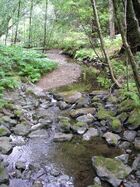Earth:Detention basin
A detention basin or retarding basin is an excavated area installed on, or adjacent to, tributaries of rivers, streams, lakes or bays to protect against flooding and, in some cases, downstream erosion by storing water for a limited period of time. These basins are also called dry ponds, holding ponds or dry detention basins if no permanent pool of water exists.
Detention ponds that are designed to permanently retain some volume of water at all times are called retention basins. In its basic form, a detention basin is used to manage water quantity while having a limited effectiveness in protecting water quality, unless it includes a permanent pool feature.[1]
Functions and design
Detention basins are storm water best management practices that provide general flood protection and can also control extreme floods such as a 1 in 100-year storm event.[2] The basins are typically built during the construction of new land development projects including residential subdivisions or shopping centers. The ponds help manage the excess urban runoff generated by newly constructed impervious surfaces such as roads, parking lots and rooftops.[3]
A basin functions by allowing large flows of water to enter but limits the outflow by having a small opening at the lowest point of the structure. The size of this opening is determined by the capacity of underground and downstream culverts and washes to handle the release of the contained water.[4]
Frequently the inflow area is constructed to protect the structure from some types of damage. Offset concrete blocks in the entrance spillways are used to reduce the speed of entering flood water. These structures may also have debris drop vaults to collect large rocks. These vaults are deep holes under the entrance to the structure. The holes are wide enough to allow large rocks and other debris to fall into the holes before they can damage the rest of the structure. These vaults must be emptied after each storm event.[5]
Research has shown that detention basins built with real-time control of the outflow from the basin are significantly more effective at retaining total suspended solids and associated contaminants, such as heavy metals, when compared to basins without control.[6]
Extended detention basin
A variant basin design called an extended detention dry basin can limit downstream erosion and control of some pollutants such as suspended solids. This basin type differs from a retention basin, also known as a "wet pond," which includes a permanent pool of water, and which is typically designed to protect water quality.[7][8][9]
While basic detention ponds are often designed to empty within 6 to 12 hours after a storm, extended detention (ED) dry basins improve on the basic detention design by lengthening the storage time, for example, to 24 or 48 hours. Longer storage times tend to result in improved water quality because additional suspended solids are removed.[7]
See also
- Best management practice for water pollution
- Groundwater banking
- Retention basin
- Stream restoration
- Sustainable urban drainage systems
- Sustainable Flood Retention Basin
- Balancing lake
References
- ↑ United States Environmental Protection Agency. Washington, DC."National Menu of Stormwater Best Management Practices." Fact Sheet: "Dry Detention Ponds."
- ↑ Atlanta Regional Commission. Atlanta, GA. "Georgia Stormwater Management Manual." Section 3.4.1: "Dry Detention / Dry ED Basins." August 2001.
- ↑ March 04; Denchak, 2019 Melissa. "Green Infrastructure: How to Manage Water in a Sustainable Way" (in en). https://www.nrdc.org/stories/green-infrastructure-how-manage-water-sustainable-way.
- ↑ Dykehouse, Terry, P.E. Jones and Edmunds, Gainesville, FL."Retention Ponds and Detention Ponds, The Recovery Process."
- ↑ "Enviro-Stormwater Management". https://www.stormwaterva.com/facilities.html#:~:text=Offset%20concrete%20blocks%20in%20the,vaults%20to%20collect%20large%20rocks.&text=The%20holes%20are%20wide%20enough,the%20rest%20of%20the%20structure..
- ↑ "Ecohydraulic-driven Real-Time Control of Stormwater Basins". Universite Laval. http://modeleau.fsg.ulaval.ca/fileadmin/modeleau/documents/Publications/pvr862.pdf.
- ↑ 7.0 7.1 Water Environment Federation, Alexandria, VA; and American Society of Civil Engineers, Reston, VA. "Urban Runoff Quality Management." WEF Manual of Practice No. 23; ASCE Manual and Report on Engineering Practice No. 87. 1998. ISBN:1-57278-039-8. Chapter 5.
- ↑ James Worth Bagley College. "Detention Basins." Chapter 4: Best Management Practices. Agricultural and Biological Engineering, College of Agriculture and Life Sciences.
- ↑ Minnesota Pollution Control Agency. "Stormwater Detention Ponds." Chapter 5, Minnesota State Permit Guidance Document.
External links
- Detention vs. retention - Project Brays (Harris County, Texas)
- Maintaining Your BMPs: A Guidebook for Private Owners & Operators in Northern Virginia
 |




